Many strange archeological discoveries have been made in modern history. Hundreds of artifacts have been unearthed that have baffled scientists and challenged modern man’s view of history. Many of these objects have been labeled out of place artifacts or anachronisms. These archeological discoveries are always controversial and the scientific community is extremely selective in what they accept as fact. Every object on this list has been accused of being an elaborate hoax. In many cases, a conspiracy is the only explanation, without an extensive rewriting of the world’s history books. These artifacts tell a story of ancient civilizations, Pre-Columbian trans-oceanic contracts, and mysterious technological advancements. Many of these archeological discoveries challenge the scientific theory of evolution, as well as many religious beliefs.
10. Acámbaro Figures
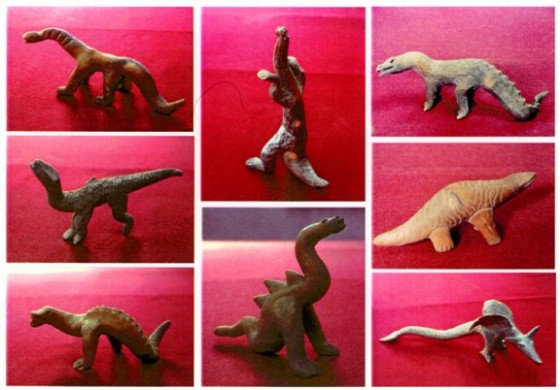
Discovered: 1944
The Acámbaro Figures are a collection of small ceramic figurines allegedly found in Acámbaro, Guanajuato, Mexico. They were discovered by Waldemar Julsrud in July of 1944. According to accounts, Julsrud stumbled upon the artifacts while riding his horse in the Acámbaro area. He hired a local farmer to dig up the remaining figures, paying him for each object he found. Eventually, the farmer and his assistants discovered over 32,000 figures, which included representations of everything from dinosaurs to people from all over the world, including Egyptians, Sumerians, and bearded Caucasians. The Acámbaro Figures have been cited as out of place artifacts, as they are clearly human made and portray a large variety of dinosaur species. According to all history books, humans did not live in the time of the dinosaurs. Upon the discovery of the figures, many creationists from all over the world proclaimed the artifacts legitimate. If these figures are genuine, it could stand as credible evidence for the coexistence of dinosaurs and humans, which would severely damage the theory of evolution and offer support for the literal interpretation of the Bible.
Attempts have been made to date these figures using Thermoluminescence, or TL dating, and the results suggested a date around 2500 BCE. A man named Don Patton claims he found radiocarbon dates for the figures ranging from 6500 years to 1500 years ago; however, the objects are in very good shape and show no characteristic evidence of having been in the ground for at least 1500 years. If they were authentic artifacts, they should be scratched and marred from the rocky soil, which is characteristic of other objects found in that area of Mexico. Other supporters of the figures claim that the incredible detail of the dinosaurs suggest a firsthand experience with the creatures. The sheer number of the figures discovered is often cited as evidence for a hoax. To date, no credible scholars of archaeology or paleontology accept the discovery as valid.
9. The Dropa Stones
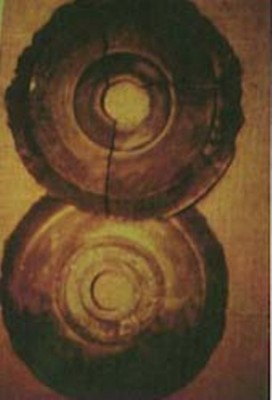
Discovered: 1938
In 1938, an archeological expedition was sent to investigate a secluded area of the Baian-Kara-Ula Mountains on the border that divides China and Tibet. The group discovered a series of caves at the summit of the mountains. The caves contained a large collection of graves and the walls were decorated with drawings of people with elongated heads together with images of the sun, moon, and stars. The archeologists uncovered the graves and discovered the remains of ancient beings. The skeletons were a little more than three feet tall, with abnormally large skulls. Inside of the tombs a collection of stone disks were recovered. The disks were almost twelve inches in diameter, with a hole in the center. The objects had a groove on the surface of the disk and spiraled outwards from the center hole forming a double spiral. Closer inspection showed that the grooves were actually a line of small carvings or signs.
The disks were labeled the Dropa Stones. Subsequent investigations have found a total of 716 Dropa Stones in the Baian-Kara-Ula Mountain caves. The Dropa Stones were sent to a variety of scholars for investigation. One of them, Professor Tsum Um Nui of the Beijing Academy for Ancient Studies, found that the spiral grooves were actually a line of characters written in an unknown language. In 1962, he announced that he had managed to translate the language. For a long time, the Peking Academy of Prehistory forbade the professor from publishing anything about the Dropa Stones. However, after many years of debate he published his hypothesis.
Tsum Um Nui claims that an alien spacecraft crashed in the Bayan Har Shan region 12,000 years ago. The occupants were aliens called Dropa or Dzopa. The Dropa could not repair their craft, so they tried to adapt to the conditions on Earth. Meanwhile, the local Ham tribesmen hunted down and killed most of the aliens. Supposedly, the aliens had intermarried with the locals, making identification of the origins of the skeletons more difficult. Many people have challenged these claims and Tsum Um Nui was forced to resign from the Beijing Academy. The Dropa Stones have been disappearing all over the world and are not available for public viewing at any museum. However, pictures of the artifacts do exist.
8. Horned Human Skull
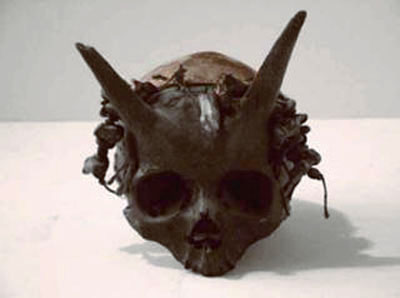
Discovered: 1880s
Sayre is a borough in Bradford County, Pennsylvania, 59 miles northwest of Scranton. The exact year is not clear, but during the 1880s a large burial mound was discovered in Sayre. It was reported that a group of Americans uncovered several strange human skulls and bones. The skeletons belonged to anatomically normal men with the exception of bony projections located about two inches above the eyebrows. It appeared that the skulls had horns. The bones were characterized as giant, as they were representative of people over seven feet tall. Scientists estimated that the bodies had been buried around A.D. 1200. The archeological discovery was made by a reputable group of antiquarians, including Dr. G.P. Donehoo, the Pennsylvania state dignitary of the Presbyterian Church; A.B. Skinner, of the American Investigating Museum; and W.K.Morehead, of Phillips Academy, Andover, Massachusetts.
It was not the first time that gigantic horned skulls have been unearthed in North America. During the 19th century, similar skulls were discovered near Wellsville, New York and in a mining village close to El Paso, Texas. At one time in history, human horns were used as signs of kingship. Alexander the Great was depicted with horns on some of his coins. In Moses’ time, horns were a symbol of authority and power. Many gods, including Yahweh, have been depicted with horns. According to historical accounts, the Sayre bones were allegedly sent to the American Investigating Museum in Philadelphia. However, the artifacts were stolen and never seen again. Apparent pictures of the skulls do exist, but many people claim the discovery to be a hoax. Many websites suggest that the objects are of extraterrestrial origin.
7. Map of the Creator
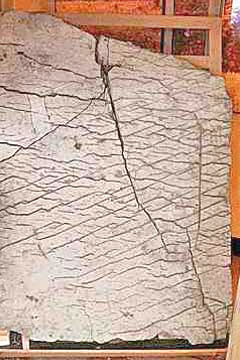
Discovered: 1999
In 1999, a professor at Bashkir State University in Russia named Alexander Chuvyrov made a remarkable archeological discovery. He was called to the house of Vladimir Krainov, who reported a strange slab buried in his backyard. Chuvyrov was instantly intrigued, as he had been searching for similar slabs that have been cited in various historical manuscripts. The slab was so heavy that it took over a week to unearth. The discovery was named the Dashka stone and later titled the Map of the Creator. The artifact is approximately 5 feet high, 3.5 feet wide, .5 feet thick, and weighs at least one ton. The stone was investigated and determined to be some sort of three-dimensional relief map of the Ural Region. Today’s military uses similar maps to measure elevation and terrain. The Dashka stone reportedly contains representations of civil engineering work, weirs, an irrigation system, and powerful dams. To date, the ancient technology used to make the map is unknown and extremely advanced.
The map also contains numerous inscriptions. At first, the scientists thought that it was an Old Chinese language, although it was later reported that the inscriptions were done in a hieroglyphic-syllabic language of unknown origin. A group of Russian and Chinese specialists in the fields of cartography, physics, mathematics, geology, chemistry, and Old Chinese language researched the artifact and were the ones that identified it as a map of Ural region, with rivers Belya, Ufimka, and Sutolka listed. Dating of the slab was reported to be over 100 million years old, but I couldn’t find any reliable resources citing evidence of what type of test was used or the exact results. If the Map of the Creator is genuine then it would suggest the existence of an ancient highly developed civilization. Researchers have claimed that a three-dimensional map of this order could have only been used for navigational purposes. Many websites claim that the slab is proof of ancient flight. Recent discoveries indicate that the slab is a piece of a larger artifact. The Dashka stone continues to undergo scientific testing and is not available for public viewing.
6. Aluminium Wedge of Aiud
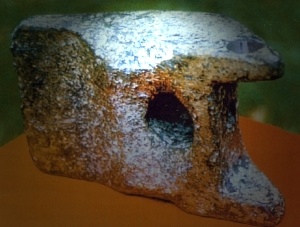
Discovered: 1974
The Aluminum Wedge of Aiud is a wedge-shaped object found two kilometers east of Aiud, Romania, on the banks of the Mures River in 1974. The object was reported to be unearthed 35 feet under sand and alongside two mastodon bones. A mastodon is an extinct large tusked mammal species. Physically, the artifact looked similar to the head of a hammer. The wedge was allegedly taken to the Archeological Institute of Cluj-Napoca to be examined, where it was found to be made of an alloy of aluminum encased in a thin layer of oxide. The alloy of the wedge is composed of 12 different elements. This artifact is considered strange because aluminum was not discovered until 1808 and not produced in quantity until 1885. Aluminium requires 1,000 degrees of heat to be made. The fact that the wedge was found in the same layer of earth as mastodon bones would make it at least 11,000 years old.
Many people have claimed that the artifact is proof that aliens visited Earth. Engineers have reported that the object resembles the foot of landing gear, not unlike the technology used on spaceships. The scientific community believes the wedge was made on earth and its purpose is not yet identified. Due to the limited amount of information that exists on the subject, the antiquity and origin of the artifact is unclear. The Aluminium Wedge of Aiud is not on display to the public and remains in an undisclosed location. However, pictures of the wedge do exist.
5. Los Lunas Decalogue Stone
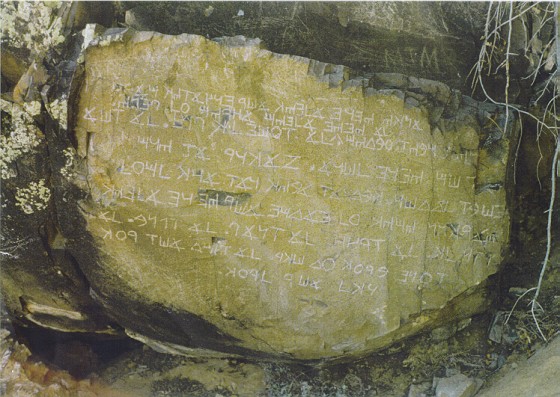
Discovered: 1880s
The Los Lunas Decalogue Stone is a large boulder on the side of Hidden Mountain, near Los Lunas, New Mexico, about 35 miles south of Albuquerque. The stone bears a regular inscription carved into a flat panel. The inscription is interpreted by some to be an abridged version of the Decalogue or Ten Commandments in a form of Paleo-Hebrew. A letter group resembling the tetragrammaton YHWH, or “Yahweh,” makes four appearances on the stone. The first recorded mention of the artifact is from 1933 when Professor Frank Hibben, an archaeologist from the University of New Mexico, reportedly saw it. Hibben was led to the stone by an unnamed guide who claimed to have found it as a boy in the 1880s. If this information is accurate, a forgery would be unlikely because the Paleo-Hebrew script was unknown to scholars in the 1880s.
One argument against the stone’s authenticity is the apparent use of Modern Hebrew punctuation, although epigrapher Barry Fell argued that the punctuation is consistent with antiquity. Other researchers dismiss the artifact based on the numerous stylistic and grammatical errors that appear in the inscription. The stone is controversial because many feel the artifact is Pre-Columbian and proof of early Semitic contact with the Americas, providing evidence that people from Israel settled in America. Because of the stone’s weight of over 80 tons, it was never moved to a museum or laboratory for study and safekeeping. The stone is accessible to visitors by purchasing a $25 Recreational Access Permit from the New Mexico State Land Office.
4. Piri Reis Map
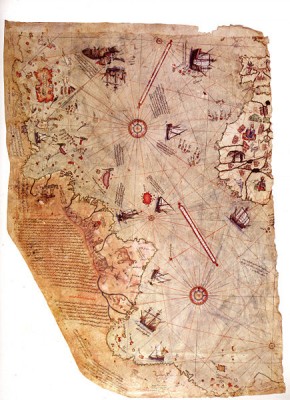
Discovered: 1929
The Topkap? Palace is a historical structure that is located in Istanbul, Turkey. The palace was the official and primary residence of the Ottoman Sultans for 400 years of their 600-year reign, from 1465 to 1856. In 1929, the Topkap? Palace was converted into a museum. Many ancient artifacts were found during the building’s reorganization and the Piri Reis map was discovered. The map drew immediate attention as it was one of the earliest maps of America, and the only 16th century map that shows South America in its proper longitudinal position in relation to Africa. The map is drawn on gazelle skin and was compiled in 1513 by Ottoman-Turkish military admiral and cartographer Piri Reis. The half of the map which survives shows the western coasts of Europe, North Africa, and the coast of Brazil. Various Atlantic islands, including the Azores and Canary Islands are shown, as is the mythical island of Antillia and possibly Japan.
The most puzzling aspect of the map is its depiction of Antarctica. According to the history books, the first confirmed sighting of Antarctica occurred in 1820 by the Russian expedition of Mikhail Lazarev and Fabian Gottlieb von Bellingshausen. The Piri Reis map not only shows a land mass near present day Antarctica, but it depicts Antarctica’s topography as not being masked by ice and in great detail. It has been estimated that Antarctica has been covered with ice for around 6000 years. Many people have raised the question, how could a Turksih admiral from half a millennium ago map a continent’s topography that has been covered with ice for thousands of years? Reports have been published claiming that the Ottoman Empire had knowledge of some form of ancient Ice Age civilization. However, these claims are generally considered to be pseudo-scholarship, and the scholarly opinion is that the region sometimes thought of as Antarctica is more likely Patagonia or the Terra Australis Incognita (Unknown Southern Land) widely believed to exist before the Southern Hemisphere was fully explored.
On the map, Piri Reis gives resource credit to a map drawn by Christopher Columbus, which has never been discovered. Geographers have spent several centuries unsuccessfully searching for a “lost map of Columbus” that was supposedly drawn while he was in the West Indies. After the discovery of the Piri Reis map, an unsuccessful investigation was launched to find the lost Columbus source map. The historical importance of the Piri Reis map lies in its demonstration of the extent of Portuguese knowledge of the New World in 1510. The Piri Reis map is currently located in the Library of the Topkap? Palace in Istanbul, Turkey, but is not currently on display to the public.
3. Giants of North America
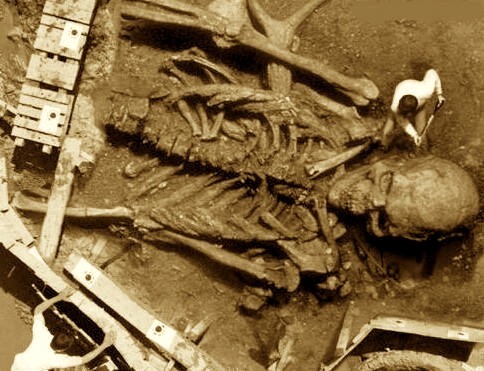
In the last few centuries, many strange archeological discoveries have been made in the Americas. It seems that people are unearthing extremely unusual and giant human remains. Many documented accounts of these findings exist. Giant human remains are classified as any bones representative of a person between seven and twelve feet in stature. A human skeleton measuring 12 feet tall was unearthed at Lompock Rancho, California, in 1833 by soldiers digging a pit for a powder magazine. The specimen had a double row of teeth and was surrounded by numerous stone axes, carved shells, and porphyry blocks with abstruse symbols associated with it. In 1856, a decaying human skeleton measuring 10 feet 9 inches tall was unearthed by laborers plowing a vineyard in what is now West Virginia. A mound discovered near Toledo, Ohio in 1895 held 20 skeletons; they were seated and facing east with jaws and teeth “twice as large as those of present day people.” In 1928, a farmer digging a pit to bury trash near Waterproof, Louisiana unearthed a 9 foot 11 inch tall skeleton.
The list of these discoveries is quite extensive and many claims have been made about the origin of these giant bones, usually starting and ending with Sasquatch. Others have suggested an ancient race of giant humans. In 1947, a strange article was posted in a Nevada state newspaper, titled ‘Atlantis in the Colorado River Desert’. The article discussed an incredible archeological discovery of 32 underground caves within a 180 square mile radius. The report indicated that the caves were discovered close to the Nevada and California border. The remains of ancient, strangely costumed 8 -9 foot giants were inside. They had been laid to rest wearing the skins of unknown animals similar to sheepskins fashioned into jackets with pants described as “prehistoric suits.” The same burial place had been cited 10-15 years earlier by another man who supposedly made a deal with the Smithsonian. Claims have been made that the evidence of his find was stolen and covered up by Darwinian scientists to protect the theory of evolution.
The caves were reported to have been discovered by Dr. F Bruce Russell. He initially described the finding as the burial place of a tribal hierarchy. He felt that some unknown catastrophe had driven these beings into the caves. All of the implements of their civilization were there, including household utensils and stoves. Well-preserved remains of dinosaurs, saber-toothed tigers, imperial elephants, and other extinct beasts were found. No physical archeological evidence of these claims has ever been displayed. Photo: worth1ooo.com.
2. Kensington Runestone
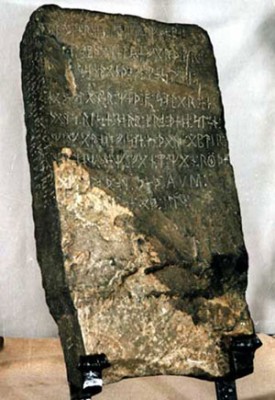
Discovered: 1898
In 1898, a Swedish American farmer named Olof Öhman claims to have discovered a large stone while clearing his land of trees and stumps. The object was attached to the roots of a small tree. Öhman didn’t realize what he had discovered, so he took the 200 pound stone to the prominent citizens of Kensington. Kensington was a settlement in Douglas County, Minnesota. The Kensington Runestone is full of ancient writing and carved text. It is thirty-one inches high, sixteen inches wide, and six inches thick. Nine years after the discovery of the artifact, Hjalmer R. Holand from Wisconsin University announced that he had deciphered the writings. He claims the text to read “8 Goths and 22 Norwegians on exploration journey from Vinland over the west. We camp by 2 skerries one day-journey from this stone. We were and fished one day. After we came home, 10 men red with blood and tortured. Hail Virgin Mary, save from evil. Have 10 men by the sea to look after our ship, 14 day -journeys from this island year 1362.”
After Holand published his findings, a massive investigation was conducted. If the translation is correct, the Kensington Runestone would provide evidence that Scandinavian explorers reached the middle of North America in the 14th century, nearly 130 years before Christopher Columbus. Basically, it raised eyebrows over the possibility that North European explorers predated Columbus in America. The runestone has been analyzed and dismissed repeatedly. Almost all runologists and linguists consider the artifact to be a hoax. However, many people believe it is authentic. If the legend on the stone is true, it means that Vikings were in central Minnesota in 1362. That would require a major rewriting of world history and geography. The Kensington inscription consists of thirty different runic characters.
In July 2000, just over a hundred years after the Kensington Runestone was found, a detailed physical analysis of the artifact was conducted. In November 2000, geologist Scott F. Wolter presented preliminary findings suggesting the stone had undergone an in-the-ground weathering process of a minimum of 50–200 years in natural conditions. Scott F. Wolter has written a number of books on the Kensington Runestone. He has suggested that the stone was made by the Vikings Knight Templar in 1362, fifty years after the dissolution of the Knight Templar and several hundred years after the end of the Viking age. He also claims that the North American expedition helped Columbus find his way around the West Indies in 1492. The artifact remains a mystery. You can view it at the Runestone Museum in downtown Alexandria, Minnesota.
1. The Shroud of Turin
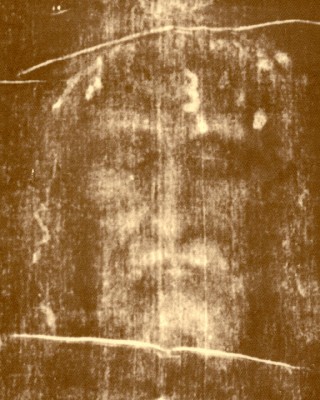
The Shroud of Turin is a linen cloth bearing the image of a man who appears to have suffered physical trauma in a manner consistent with the crucifixion of Jesus Christ. The linen is a full body portrait and measures 14 feet, 3 inches long by 3 feet, 7 inches wide. The shroud is wrapped in red silk and has been kept in a silver chest in the Chapel of the Holy Shroud in the Cathedral of St. John the Baptist in Turin, Italy since 1578. The origins of the artifact and its image have been the subject of intense debate among scientists, historians, and researchers. Believers contend that the shroud is the cloth that was placed on the body of Jesus Christ at the time of his burial, and that the face image is the Holy Face of Jesus. Detractors contend that the shroud cloth material postdates the crucifixion of Jesus by more than a millennium. In 1988, radiocarbon dating was done on the shroud in an attempt to determine the relic’s authenticity. The test indicated that the cloth was woven between 1260 and 1390 A.D, much later than the time of Jesus.
These results have been challenged by peer-reviewed journals and many critics have raised questions about the original nature of the sample used in the test. The Catholic Church has neither formally endorsed nor rejected the shroud, but in 1958 Pope Pius XII approved the image in association with the Roman Catholic devotion to the Holy Face of Jesus. On May 28, 1898, amateur Italian photographer Secondo Pia took the first photograph of the shroud and was startled by what he discovered. The negatives gave the appearance of a positive image, which implies that the shroud itself is a negative of some kind. Image analysis by scientists at the Jet Propulsion Laboratory found that rather than being like a photographic negative, the image unexpectedly has the property of decoding into a 3-D image. This property could not be replicated by researchers. One theory is that the image on the shroud is simply painted on. Both skeptics and proponents tend to have very strong positions on the formation and discovery of the Shroud of Turin. At times the controversy is pitting science versus divine formation, which makes dialogue very difficult. The Shroud of Turin remains one of the most mysterious artifacts in the world.
source: http://www.toptenz.net/top-10-bizarre-archeological-discoveries.php

 14.38
14.38
 Peristiwa Aneh
Peristiwa Aneh

0 komentar:
Posting Komentar